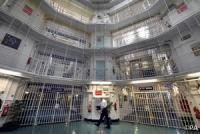-
Berlin attack: security intelligence has limits in preventing truck-borne terror
The Christmas market truck assault in Berlin, which has left twelve dead and dozens injured, is a disturbing echo of the truck-borne attack on Bastille Day celebrants on the Nice promenade in July. How could such events be allowed to happen? Why weren’t intelligence agencies in Germany and France able to stay one step ahead of the perpetrators? The role of the security and intelligence agencies to remain vigilant and seek to monitor extremist elements will undoubtedly endure. The secret of their success will continue to be keeping their successes secret. However, this does not absolve the rest of society from remaining engaged in community, by being inclusive, welcoming, and helpful, while also maintaining a level of vigilance many had come to associate with a bygone era.
-
-
1,900 arrest-related deaths in U.S. between June 2015-May 2016: Study
The Bureau of Justice Statistics (BJS) Arrest-Related Deaths program estimates that there were 1,900 arrest-related deaths in the United States between June 2015-May 2016. These deaths include all persons who died during the process of arrest or while in police custody, including deaths due to homicide, justifiable homicide by a law enforcement officer, suicide, accidental injury, and natural causes.
-
-
A license to print: how real is the risk posed by 3D printed guns?
3D printed guns are back in the news after Queensland Police reported last week that they had discovered a 3D printer in a raid on what appeared to be a “large-scale” weapons production facility as a part of Operation Oscar Quantum. But the fact is that 3D printing technology is not yet at the stage where it can readily produce weapons. Although it can be used to help rogue gunsmiths work their shady trade. And we should remember that it’s not only 3D printing that enables people to build illicit firearms. With the right tools, a skilled gunsmith can make a weapon in their back shed. However, 3D printing can make that process easier and more accessible to less skilled individuals.
-
-
It is time to stop using bite marks in forensics: Experts
Forensic dentists claim that they can accurately associate a bite mark to the one and only set of teeth in the world that could have produced the crime scene bite mark. There is, however, no sound basis for believing that forensic dentists can do such a thing, and researchers are increasingly skeptical about the validity of bite-mark identification as trial evidence.
-
-
Police say they lack powers to probe phone involvement in crashes
Four out of five collision investigators surveyed for the research indicated mobile phone involvement in non-fatal accidents was under-reported, with half agreeing the role of phones was even overlooked in fatal crashes. Police officers are worried they lack the right powers and resources properly to investigate whether a mobile phone was being used by a driver at the time of a crash, a new study has found.
-
-
Number of Americans kidnapped, killed in Mexico increases
The number of U.S. citizens kidnapped in Mexico each year is uncertain due to false reporting and underreporting, but in 2014 the FBI investigated at least 199 kidnappings of U.S. citizens in Mexico, a substantial increase from twenty-six kidnappings in 2006. The number of U.S. citizens reported to the Department of State as murdered in Mexico was 100 in 2014 and 103 in 2015.For the family of Norma Magallanes Benitez, a U.S. citizen who was kidnapped on 21 October 2016 while visiting her family ranch in the municipality of Luvianos, Mexico State, these figures are not dry statistics.
-
-
Extreme-right terrorism threat growing: U.K. police
Neil Basu, deputy assistant commissioner to the U.K. national coordinator for counter-terrorism policing, has said police fear the threat of far-right violence is growing and poses a similar danger to communities as other forms of extremism. “Over the past twelve months, there have been indications that the threat from [the] extreme right wing could be increasing and we are alive to this,” he said. Figures release by the police show that concerns over potential extreme rightwing radicalization led to a 73.5 percent increase in referrals to the counter-radicalization program Prevent last year, compared with the previous twelve months.
-
-
Stronger gun laws linked to decreased firearm homicides
Stronger firearm laws are associated with reductions in firearm homicide rates, concludes a study which reviewed all available articles published in peer-reviewed journals from January 1970 to August 2016 that focused specifically on the connection between firearm homicide and firearm laws. Specifically, the laws that seemed to have the most effect were those that strengthened background checks and those that required a permit to purchase a firearm. Laws that banned assault weapons, improved child safety, or aimed to limit firearm trafficking had no clear effect on firearm homicide rates. Laws that aimed to restrict guns in public places had mixed results.
-
-
Most border arrests by Texas troopers are not for drug smuggling
Officers with the Texas Department of Public Safety (DPS) have recorded 31,786 law violations along the Texas-Mexico border from late June 2014 through September 2016. Just 6 percent of the offenses were felony drug possession by “high-threat criminals,” or HTC — the criminals troopers were largely sent to stop. The other HTC priority is supposed to be human smugglers, but they made up just 1 percent of offenses. DPS has added more troopers to the border under the assumed objective that they are going after drug and human smugglers — but a close examination shows that most of their arrests are for drunk driving and misdemeanor drug possession.
-
-
Florida's Stand Your Ground law linked to rise in homicide rates in the state
Before 2005, Florida’s so-called “Castle doctrine” allowed the use of lethal force in situations where individuals believed there was an imminent threat of death or serious physical harm from an intruder within their own home. In 2005 Florida enacted the Stand Your Ground law, extending the “no duty to retreat” clause of the Castle doctrine, giving individuals immunity for using lethal force to defend themselves in public places, as well as on private property. Anew analysis shows that thechange in Florida’s self-defense laws has been linked with the state’s homicide rates going up by nearly a quarter.
-
-
FBI releases hate crime statistics report
The FBI says that hate crimes can have a devastating impact upon the communities where they occur, which is one of the reasons why the investigation of hate crimes that fall under federal jurisdiction is the number one priority under the FBI’s civil rights program. The Bureau’s just-publishedreport, covering 2015, reveals 5,850 criminal incidents and 6,885 related offenses that were motivated by bias against race, ethnicity, ancestry, religion, sexual orientation, disability, gender, and gender identity.
-
-
Forensic technique to measure mechanical properties of evidence
You may have seen it on CSI: The star examines hair from a crime scene and concludes its color or texture looks like the defendant’s hair, or maybe his dog’s. Case closed. But looks can be deceiving, as well as vague and subjective. In real life, the FBI is now reviewing thousands of cases involving hair comparisons going back to the 1980s because traditional identifications—often based on looks alone — have been called into question. Instead, what if investigators could precisely measure a hair’s mechanical properties — its stiffness and stickiness? Researchers say that in fact, they can.
-
-
Less crime, and fewer incarcerations: As New York became a safer city, prisons closed too

Overflowing prison populations and high rates of violent crime once made New York City a metaphor for the urban decay confronting America’s cities. But over the last two decades crime in the nation’s largest city has declined steeply, with murders plummeting from 2,200 in 1990 to 350 in 2015. New York City’s crime decline was coupled with a sustained and dramatic reduction in incarceration, allowing the state to close more than a dozen prisons and save tens of millions of dollars. New York is now not only the safest big city in the United States, but also one with the fewest incarcerations for its size.
-
-
Trump's win spurs surge in private prison stocks
Shares of private prison companies Corrections Corporation of America and the GEO Group jumped 48.1 percent and 20.8 percent, respectively, on Wednesday following Tuesday’s victory by Donald Trump in the presidential election. If Trump follows through on his campaign pledge to deport millions of undocumented immigrants, this will be a boon for the private prison industry.
-
-
Loophole in Rhode Island law allows domestic abusers to keep firearms, despite risks

Courts in Rhode Island rarely require abusers to turn in their firearms, even when orders prohibit them from possessing firearms under federal law and there is evidence they pose a lethal risk to victims, according to new research. examined 1,609 case files of protective orders filed in Rhode Island Family and District courts from 2012 to 2014. “In Rhode Island, domestic abusers are rarely required to turn in their firearms — even when they are federally prohibited from possessing them,” said one researcher. “Addressing this gap in the state’s law could help prevent risk of gun violence to potential abuse victims.”
-
More headlines
The long view
Why Was Pacific Northwest Home to So Many Serial Killers?
Ted Bundy, Gary Ridgway, George Russell, Israel Keyes, and Robert Lee Yates were serial killers who grew up in the Pacific Northwest in the shadow of smelters which spewed plumes of lead, arsenic, and cadmium into the air. As a young man, Charles Manson spent ten years at a nearby prison, where lead has seeped into the soil. The idea of a correlation between early exposure to lead and higher crime rates is not new. Fraser doesn’t explicitly support the lead-crime hypothesis, but in a nimble, haunting narrative, she argues that the connections between an unfettered pollution and violent crime warrant scrutiny.
